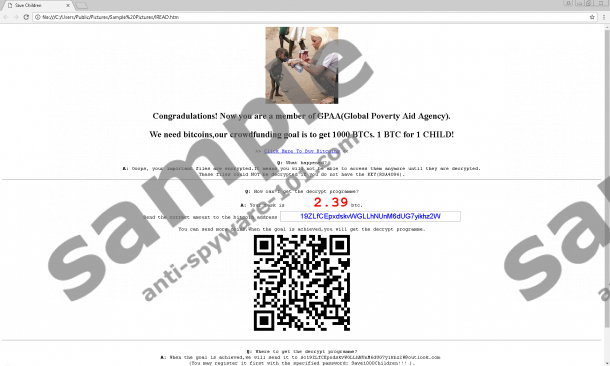What is Gpaa Ransomware?
Gpaa Ransomware is a recently discovered ransomware-type computer infection that was first sighted in June of 2017. This infection pretends to serve a noble cause of helping poor children around the world. It demands Bitcoins to help them, but the reality is that all of that money will go to cyber criminals. Furthermore, this ransomware is configured to encrypt your files, and there is no free decryption tool. So your options are: to comply with the demands and pay the ransom or to refuse to pay it and remove the infection. However, if you decide to delete it, then your files will remain encrypted until, and unless, a free decryption tool is created.

Where does Gpaa Ransomware come from?
Our malware analysts have concluded that Gpaa Ransomware’s creators distribute it using two sneaky distribution channels. Apparently, the creators have somehow managed to employ Remote Desktop Protocol (RDP) that provides users with a graphical user interface to connect to another computer over a network connection. The details surrounding this method of distribution are mostly unclear, and we do not think that using this method gets many computers infected. However, the other distribution method is very effective indeed. Researchers say that this program’s creators use malicious emails to infect the computers of unwary users. They probably disguise the emails under the guise of helping children. Gpaa stands for Global Poverty Aid Agency which might look like a legitimate legal body, so you may be tricked into opening the file attached to the email.
What does Gpaa Ransomware do?
If you download and open the attached file, then your PC will become infected with Gpaa Ransomware. You may find the randomly named executable of the file in your Downloads folder, desktop or wherever you point your downloads to. If you opened the file by downloading the file temporarily, then you may find this executable in the %TEMP% folder. This ransomware uses an advanced encryption algorithm, and there is no free decryption tool available. It was configured to encrypt many file types that include but not limited to .123, .3dm, .3dmap, .3ds, .3dxml, .3g2, .3gp, .wma, .wmv, .wrl, .xl, .xlc, .xlm, .mp3, .mp4, .mpeg, .mpg, and many others. While encrypting your files, this ransomware is set to append them with a custom “.cerber6” file extension and also change the names of the files to a random set of characters.
Once the encryption is finished,Gpaa Ransomware drops a ransom note in every folder where a file was encrypted. The note is named !READ.htm and it contains a picture of a starving 2-year-old Nigerian orphan who was being given aid by a humanitarian worker. Naturally, it also features a note claiming that “Now you are a member of GPAA (Global Poverty Aid Agency).” It is a nice way of saying that the cyber criminals got you in their grip as they and only they can give you the decryption key in exchange for 2.39 BTC which is 6085.76 USD. The note also features the Bitcoin wallet address to which you are expected to send the money. Researchers say that the ransom can very as it changes after each system restart.
How do I remove Gpaa Ransomware?
You cannot be sure whether Gpaa Ransomware’s creators will send you the decryption program once you have paid the hefty ransom. Chances are that you will lose not only your valuable files but also your money. Therefore, we advise you against paying the ransom and waiting for a free decryption tool to come out. However, it may take some time. If you want to remove this infection (and you should), then please use our manual removal guide provided below. You can also use an anti-malware program such as SpyHunter to delete it for you.
Removal Instructions
- Press Windows+E keys.
- Enter the following file paths and hit Enter.
- %TEMP%
- %USERPROFILE\Downloads
- %USERPROFILE\Desktop
- Locate the ransomware’s executable.
- Right-click it and click Delete.
- Delete all copies of !READ.htm wherever you find them.
100% FREE spyware scan and
tested removal of Gpaa Ransomware*





0 Comments.